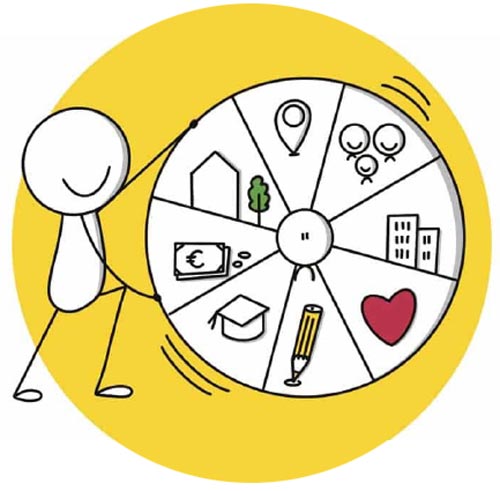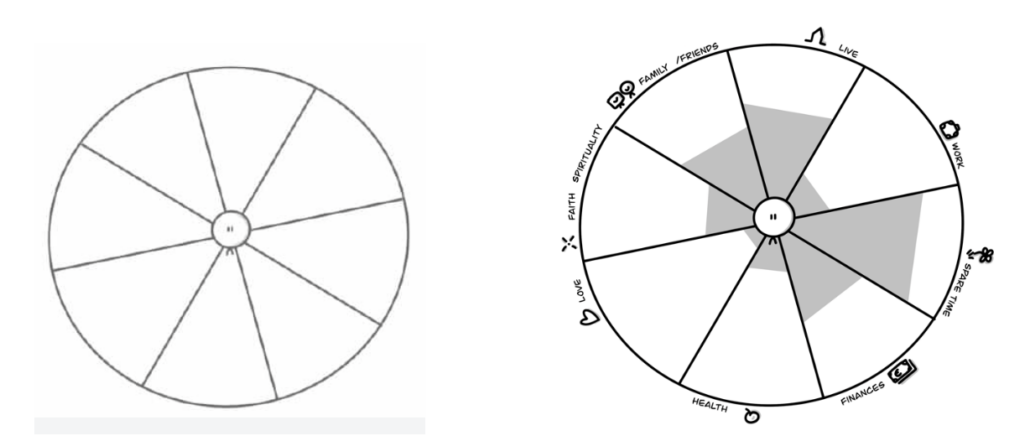Wheel of life

Your work is valuable! Care providers can make a difference, for a client, for a system, and for everyone involved. At the same time, concerns are growing, there are more people in need of assistance, more help is needed! Unfortunately, we see pressure increasing from work, patients, clients, healthcare insurers… everything must be done more and more quickly nowadays. All this while the quality of your work must remain unchanged! Without positive results, the demand for healthcare will only increase. Moreover, it is evident that positive results are necessary for those who work passionately in order to avoid burnout. Healthcare is characterized by these two factors that often seem to clash. Fortunately, this problem also stimulates creativity and problem-solving. We see caregivers with brilliant ideas! Beautiful creative initiatives lead to good results.
Working with templates is one of the ways that can help you manage time more efficiently without sacrificing quality!
Here are some examples of how templates can support you in your work:
- A template can be filled in by the client before a session with a simple explanation, allowing you to get straight to the point during the session
- A completed template can be taken home by a client and used as a summary of the conversation when discussing it with third parties
- An empowering template can be saved as a screensaver on the phone or taken home and displayed prominently. This way, the client is regularly reminded of what was previously discussed
- A photo of a completed template can be sent to the client as a reminder before a subsequent session. This refreshes the previous “conversation,” reduces the need for repetition, facilitates reflection, and allows for faster progress
In this blog post, I will share a template that I have used extensively as an art therapist and show you how it works.
You can download this template plus 2 more for free as we give away 3 templates from our book on our website here.

“The Wheel of life” is one of the 101 visual conversation templates included in our book “Conversations visualized” The book provides a brief instruction manual, which I copied here:
One way to map satisfaction in different areas of life is the so-called wheel of life. You can start by exploring together with the client which areas of life are important to them. Then you can give each domain a “pizza slice” and you let the client fill in the level of satisfaction per pizza slice. For example, a fully completed pizza slice represents 100% satisfaction. In this way you can create insight and a clear picture together with the client.
When people come to therapy, stress levels are often high. High stress tends to narrow people’s focus to tunnel vision. Looking through a tunnel not only makes the world appear darker (receiving less light), but it also limits the ability to zoom out. Zooming out is necessary to experience more breathing room and to find creative solutions. Filling in this “Wheel of life” together helps the client distance themselves from their “problem” and see the bigger picture. When the client also sees what does go well, it helps to put things into perspective. On the other hand, it helps the therapist gain insight into how the client perceives themselves and their life, and what they consider important. Of course, you can expand on working with this template. For example, you can discuss with the client which slice should be the largest. If, for instance, the relationship with a partner is the most important, that slice would be the largest; if professional achievements are considered less important, that slice would be smaller. Of course, you can also dedicate an entire slice to a specific domain. For example, “school” can consist of different sub-areas such as social contacts, interaction with teachers, homework, results, external interference, attendance, and so on. These sub-areas can be evaluated independently.
In short, do you ever work with clients who seem to suffer from hyperfocus on a specific problem? Then I would say, “Engage in the conversation using this template and experience the positive effects of working with a visual conversation template like this yourself!”
Do you want to use drawing and templates more in your sessions or conversations? Then our book “Conversations visualized” might be just right for you. In this book, we have gathered 101 conversation templates that can be readily used by care providers or therapists.
We wish you a lot of valuable drawing pleasure!
